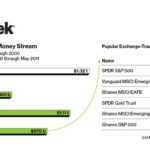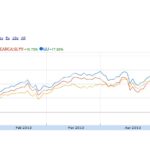Even though the S&P500 (SPY) closed the week with a respectable 2.4% gain, volatility ETNs (Exchange traded notes) showed huge gains for the week ranging from 19%-40% depending on the type of ETN. For a bit more on how the volatility index works, the VIX is the CBOE’s market volatility index which derives its volatility from the implied volatility of options on the S&P500. In essence, since volatility in options increases when market sentiment sours, the VIX is referred to as the “fear index”. Usually when markets tank, the VIX and its related proxies spike. Therein lies the rub. Last week, the S&P500 was up and VIX funds spiked. Here’s the performance of a few popular ETNs that track the vix during last week’s market action:
TVIX – CreditSuisse 2X Vix Short Term – +40%
UVXY – ProShares Ultra Vix Short Term – +38%
VXX – Barclays iPath VIX Short Term – +19%
There are actually several other ETNs tracking the VIX mid-term, inverse VIX and all sorts of other combinations which begs the question as to just how many VIX ETNs are really necessary. VXX is the most popular straight play on VIX volatility. Note that the two leveraged funds roughly doubled the return of VXX on the week. Investors lured by the prospect of doubling (or even tripling) their returns with leveraged ETFs and ETNs should take heed of the dangers of these instruments of mass destruction because leveraged ETFs decay over time due to daily value resets which takes a bit of explanation to fully understand – but it cannot be denied both mathematically and historically.
As to how the VIX could rise in the same week as a rise in the S&P500, there are a few ways this can happen. While the VIX a slight negative correlation with the S&P500, in this particular week, there was a HUGE jump in the VIX on one particular day, Tuesday, when markets tanked on concern over Europe (Greece primarily, but with Italy and others in the background should Greece default in a disorderly fashion), and when indices rose later in the week, the VIX did not drop in lockstep. Investors continue to remain concerned over an implosion in Europe which would have ripple effects worldwide and thus, put options (protection) remain pricey, thus boosting the VIX. We could easily continue to see some neutral or up weeks on indices while the VIX and proxy ETNs continue to rise.
More on ETNs vs. ETFs
ETFs (Exchange Traded Funds) and much more popular than ETNs (Exchange Traded Notes) but often times only an ETN is offered for a particular benchmark. ETFs and ETNs should also not be confused with closed end funds which have their own attributes allowing discounts and premiums as well.  The reasons are numerous, but a typical cause is that it’s not an actual stock or commodity that’s being traded, but just a benchmark. For instance, you can’t “buy” volatility per se. You don’t get a stock certificate for volatility; it’s a concept and an index based on characteristics of stock option volatility, as opposed to holding an underlying stock or physical holding. A key risk of ETNs is that when holding notes, the investor is taking on the solvency risk of the issuing party, whereas ETFs are backed up by their holdings. Under normal conditions, this risk is viewed as minimal, but as evidenced during the Financial crash of 2008-2009, it’s not unheard of to see major financial firms collapse.
Disclosure: no position in any ETFs or ETNs cited herein.











{ 0 comments… add one now }